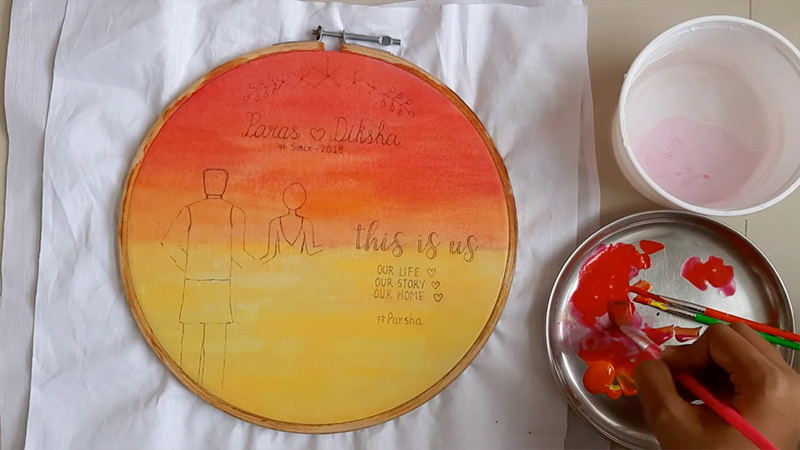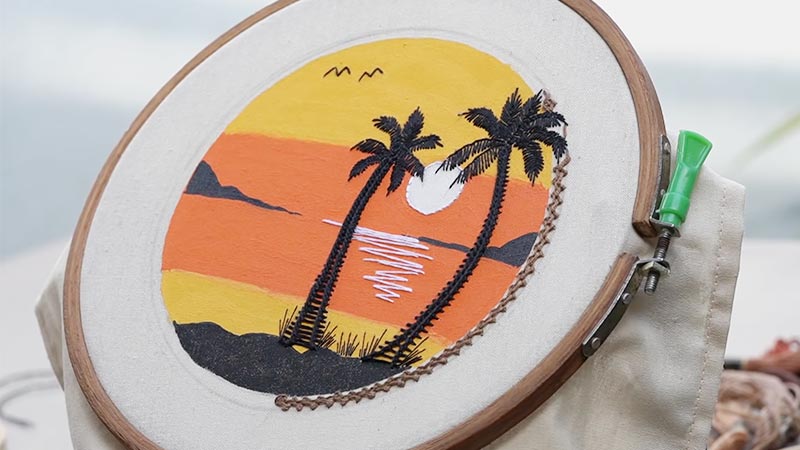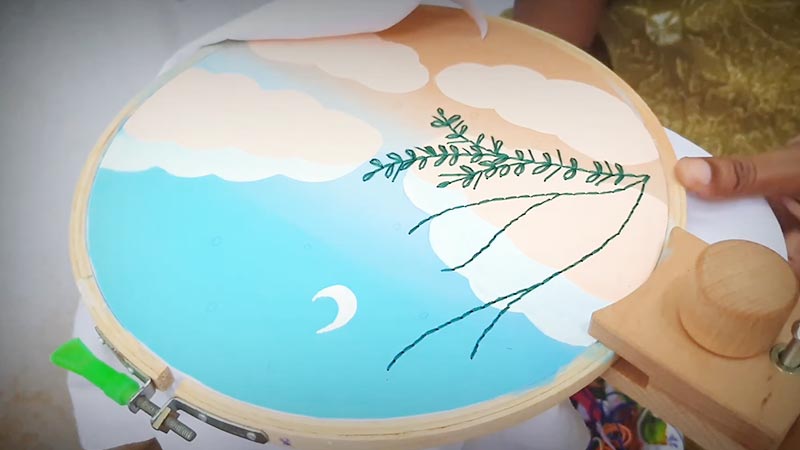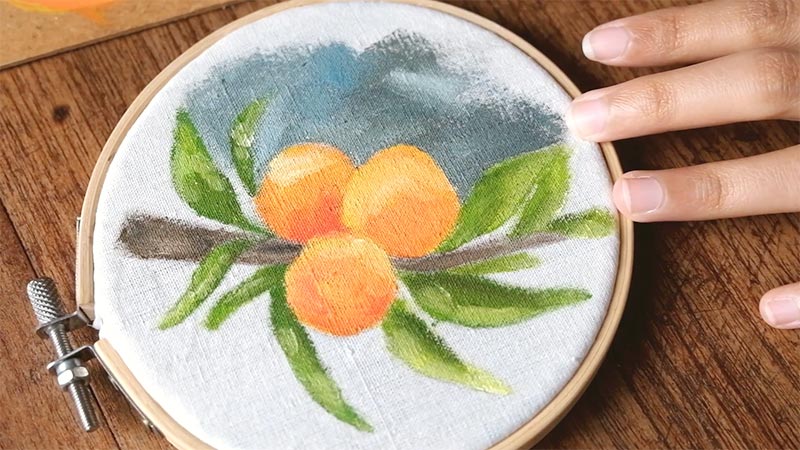When creativity meets craft, the choice of paint for your embroidery hoops plays a pivotal role in transforming your projects from ordinary to extraordinary.
In the world of embroidery, where every stitch is a stroke of artistry, the paint you use can be the brush that adds that captivating finishing touch.
The preferred paint for embroidery hoops is acrylic, celebrated for its remarkable versatility, durability, and vivid color spectrum.
In this exploration, we will unveil the reasons why acrylic paint is the go-to choice, and also consider alternative options for those seeking unique effects.
Whether you’re a seasoned crafter or an eager novice, the world of paint and embroidery beckons, promising a colorful journey of creativity.

What Paint Do You Use For Embroidery Hoops?
The ideal paint for embroidery hoops is acrylic paint. Acrylic paint offers excellent adhesion to wood surfaces commonly found in embroidery hoops, ensuring long-lasting results.
It comes in a vast array of colors and finishes, allowing for creative customization to match your embroidery designs or home decor.
Acrylic paint is user-friendly, drying quickly and cleaning up easily with water. Its affordability and availability in various price ranges make it a practical choice for both beginners and experienced crafters.
For added protection and durability, you can seal the painted surface with a clear acrylic sealer. Overall, acrylic paint is the preferred choice for adding a personalized and colorful touch to embroidery hoops.
Why Is Acrylic Paint Preferred for Embroidery Hoops?

Choosing the right type of paint for your embroidery hoops is a decision that can significantly impact the final look and longevity of your projects. Acrylic paint has emerged as the preferred choice for crafting enthusiasts and embroiderers, and for good reason.
Here’s why acrylic paint is the go-to option for enhancing the aesthetics of embroidery hoops:
Strong Adhesion
Acrylic paint excels in adhering to wooden surfaces, which are commonly found in embroidery hoops. This strong adhesion ensures that the paint bonds securely to the wood, resulting in a long-lasting finish.
Embroidery hoops are often handled and adjusted, and acrylic paint can withstand this without chipping or peeling, preserving the integrity of your design.
Diverse Color Palette
Acrylic paint offers a wide and diverse array of colors, providing a vast palette to choose from. Crafters can easily find the perfect hue to match their embroidery designs or to complement their home decor. Whether you’re working with soft pastels or bold, vibrant shades, acrylic paint allows for extensive customization.
Versatile Finishes
Acrylic paint is available in various finishes, including matte, satin, and glossy. This versatility empowers crafters to control the texture and sheen of their embroidery hoops.
You can achieve the exact look you desire, whether it’s a subtle, understated appearance or a high-gloss finish to make your design pop.
User-Friendly
Acrylic paint is known for its user-friendliness. It dries relatively quickly, making it convenient for crafters who want to move efficiently through their projects.
Cleanup is a breeze because acrylic paint is water-based, reducing the hassle associated with using certain other paint types. This makes it suitable for both beginners and experienced crafters alike.
Affordable Choice
Acrylic paint is available at various price points, accommodating different budgets. Crafters can access quality acrylic paints at affordable prices, allowing them to achieve a professional finish without breaking the bank.
This accessibility is especially advantageous for those who enjoy crafting as a cost-effective hobby.
Enhanced Durability with Sealing
For those concerned about the longevity of their painted embroidery hoops, acrylic paint readily accepts clear acrylic sealers.
Applying a clear sealer over the paint provides an extra layer of protection, ensuring that the painted surface remains vibrant and unblemished over time, even with frequent handling.
Widespread Availability
Acrylic paint is readily available in local craft stores, art supply shops, and online retailers. The ease of access to various brands and color options makes it convenient for crafters to source the specific paints they need for their embroidery projects.
How to Paint Embroidery Hoops with Acrylic Paint?

Painting embroidery hoops with acrylic paint is a creative and fun way to add a personal touch to your embroidery projects.
Here’s a step-by-step guide on how to paint embroidery hoops with acrylic paint:
Materials You’ll Need
- Acrylic paint in your desired colors and finishes.
- Embroidery hoops (disassembled into inner and outer rings).
- Fine-grit sandpaper.
- Paintbrush with fine to medium soft bristles.
- A damp cloth for cleaning.
- Clear acrylic sealer (optional for added protection).
- Workspace with proper ventilation.
Step-by-Step Guide:
Prepare Your Workspace
Set up your workspace in a well-ventilated area. Cover the surface with newspaper or a drop cloth to catch any paint drips and protect your work area.
Disassemble the Embroidery Hoops
Loosen the screw on the embroidery hoop to separate the inner and outer rings. This allows you to paint each piece separately and ensures thorough coverage.
Surface Preparation
Use fine-grit sandpaper to gently sand the wooden surfaces of the embroidery hoop rings. Sanding helps remove any rough spots, splinters, or imperfections, ensuring a smooth paint application.
Clean the Hoops
After sanding, use a damp cloth to wipe down the sanded hoops. This will remove any sanding dust and debris. Let the hoops dry completely before proceeding.
Painting
- Squeeze a small amount of acrylic paint onto a palette or disposable surface.
- Dip your paintbrush into the paint, ensuring that the bristles are evenly coated but not overly saturated.
- Begin by applying a thin, even coat of acrylic paint to the outer ring of the embroidery hoop. You can start in the center and work your way out, or vice versa, depending on your preference.
- Ensure full coverage while avoiding excessive paint buildup, which can result in an uneven finish.
Drying Time
Allow the first coat of paint to dry completely, typically for about 20-30 minutes. You can speed up the drying process by using a fan or a hairdryer in a low, cool setting.
Optional Second Coat
If you find that the first coat isn’t as opaque or vibrant as you’d like, apply a second coat of acrylic paint. Allow it to dry as well.
Sealing (Optional)
For added protection and durability, consider applying a clear acrylic sealer. Follow the manufacturer’s instructions for the sealer you’re using, ensuring that the paint is fully dry before sealing.
Reassemble the Hoops
Once the painted embroidery hoop rings are completely dry and sealed (if you’ve chosen to seal them), reassemble the inner and outer rings. Place your fabric between them and tighten the screw to create a taut surface.
Final Touches
Examine your work for any touch-ups, and make any necessary adjustments before incorporating the painted hoops into your embroidery project.
Are There Alternatives to Acrylic Paint for Embroidery Hoops?

Yes, there are alternatives to acrylic paint for painting embroidery hoops. While acrylic paint is a popular and versatile choice, some crafters and artists might prefer different types of paint for various reasons.
Here are a few alternatives to consider:
Watercolor Paint
Watercolor paints are a fantastic option if you want a translucent and delicate effect on your embroidery hoop. They work well on lightweight fabrics and can create soft, flowing designs. However, they may not adhere as strongly to wood and could require special treatment or sealing.
Oil-Based Paints
Oil-based paints are known for their rich, deep colors and ability to create smooth, glossy finishes. They are suitable for creating intricate and detailed designs on embroidery hoops. However, oil-based paints generally have a longer drying time and require solvents for cleanup.
Fabric Paint
If you’re working with fabric embroidery hoops or plan to paint directly on fabric, fabric paint is an ideal choice. Fabric paints are specially formulated to adhere well to fabric surfaces without stiffening the material. They come in various colors and can be heat-set for added durability.
Water-Based Markers
Water-based markers, such as fabric markers or permanent markers, can be used for intricate designs on embroidery hoops. They are easy to control and come in a range of colors. However, markers may not offer the same range of textures and finishes as paint.
Chalk Paint
Chalk paint is a unique option that provides a matte, vintage, and shabby-chic finish. It adheres well to wood and can create a rustic look on embroidery hoops. It is often used for distressed or weathered designs.
Spray Paint
Spray paint can be a quick and convenient option for covering large areas of embroidery hoops. It’s available in various colors and finishes, including matte, glossy, and metallic. Be sure to use it in a well-ventilated area and protect your work surface.
Gouache Paint
Gouache paint offers the opacity of acrylics with a matte finish, making it a good choice for artists who want a paint that behaves like watercolor but provides more coverage. It adheres well to wood and paper surfaces.
FAQs
What type of paint is best for embroidery hoops?
Acrylic paint is the preferred choice for embroidery hoops due to its strong adhesion, versatility, and wide color range.
Do I need to prepare the embroidery hoop before painting?
Yes, it’s essential to sand the surface lightly and clean it before painting to ensure better adhesion and a smooth finish.
How can I prevent paint from chipping on my embroidery hoops?
Proper surface preparation and sealing the painted surface with clear acrylic sealer can help prevent chipping.
Are there specific brands of acrylic paint recommended for embroidery hoops?
While there are many quality brands, it’s a matter of personal preference. Popular choices include Liquitex, Golden, and DecoArt.
Can I paint directly on fabric embroidery hoops?
Yes, you can use fabric paint or other suitable paints for fabric to decorate fabric embroidery hoops.
To Recap
As our exploration of the perfect paint for embroidery hoops draws to a close, we’ve uncovered the brushstrokes of creativity that make acrylic paint the preferred choice.
Its strong adhesion, diverse color palette, versatile finishes, and user-friendliness offer an artistic playground for crafters, whether experienced or just starting out.
The affordability and accessibility of acrylic paint ensure that crafting remains an accessible endeavor, allowing your imagination to take center stage.
With the option to seal for added protection and longevity, your painted embroidery hoops can withstand the test of time.
So, as you embark on your next embroidery journey, remember that the choice of paint is not merely a technical detail but a vibrant expression of your creativity, waiting to adorn your projects with a personalized touch.
Leave a Reply